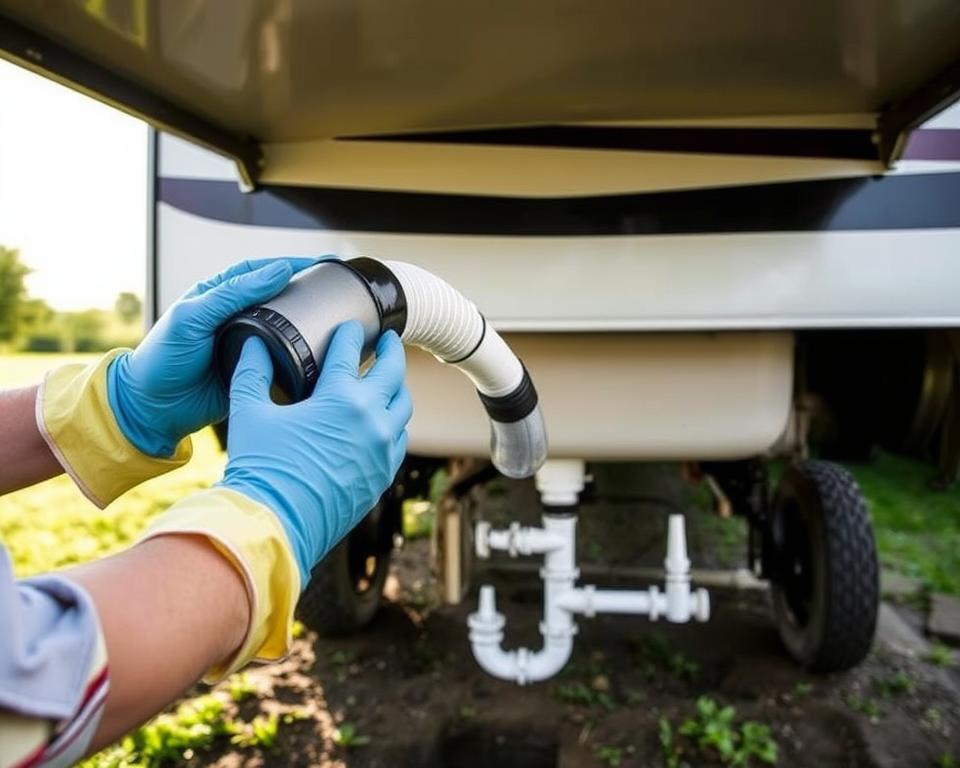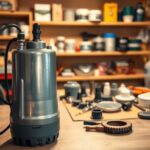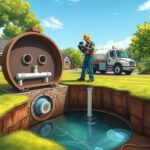RV Water Tank plus Pump: – Complete Manual
Have you ever questioned how seasoned RVers maintain perfect water flow while boondocking? It’s all about your RV water Tank and Pump. Be it bound for the national-park circuit or a simple weekend retreat, understanding your RV’s water system is essential. In this guide we break down the basics: the elements, servicing, and strategies for trouble-free travel. Grasping each component, from the pipework to Tank filling, secures water is always ready during your excursions – RV holding tank pump out service near me.
Core Takeaways
- Mastering the RV water system improves your travel enjoyment.
- The RV water Tank and Pump are indispensable for a reliable water supply.
- Routine servicing extends the service life of your RV plumbing.
- Knowing how to fill your Tank correctly can prevent future issues.
- Troubleshooting your water Pump can rescue you from unexpected problems.
Getting to Know RV Water Systems
RV water systems divide into two main parts: the fresh-water setup and the grey/black-water mechanism. The fresh side boasts several key elements like the water Tank, Pump, and faucets, resembling household plumbing but adapted to the mobile needs of living on the move.
Ensuring drinkable water is crucial for the system’s reliability. It safeguards the well-being of all passengers. It’s imperative to keep the RV plumbing in excellent order through regular maintenance – covering proper drainage to prevent leaks and other hiccups. Proactive inspections help RV enthusiasts dodge water-related headaches during their journeys.

The Importance of the RV Fresh-Water Tank
The RV water Tank is central for a smooth journey. It stores the fresh water required for drinking, cooking, and cleaning. The size of this container differs with each RV model, affecting how much water can be stored – and this directly influences how long you can travel before requiring a refill.
Maintaining the RV water Tank sanitary is vital. Periodic cleaning prevents dangerous contaminants, ensuring water stays safe for use. Skipping maintenance can encourage bacteria or algae growth, rendering the water hazardous.
Understanding the RV Tank’s role enhances water management during trips. Proper upkeep and regular refills ensure a worry-free experience. It’s key to have ample water for all travel needs, guaranteeing a smooth RV adventure.
Filling Your RV Water Tank
Filling your RV water Tank demands careful action to confirm it’s done correctly. There are two primary methods: gravity filling and city-pressure filling. Perfecting these techniques greatly improves your RV conditions.
Gravity-feed is straightforward. You just need a drink-safe water hose. Attach this hose to a water source, then to the fill opening, and let gravity take over. Remember to keep an eye on the water level to prevent spills.
Pressure filling involves a city water connection, which is faster delivery. You must use a pressure regulator to control water flow. Connect the hose from the municipal source to your RV. This approach ensures speedy and consistent supply to your reservoir.
Choosing approach you select, adhere to these important safety tips: Consistently monitor the fill when filling to prevent overflow, and use potable water to avoid health issues. Mastering these filling and safety techniques will turn your RV trips even more enjoyable.
RV Water System: Parts in Focus
The RV Tank-and-Pump combo are critical to any RV’s plumbing system, ensuring a reliable and dependable water supply for all your needs. The RV water Pump’s main job is to push water from the Tank, ensuring clean water is always available. That’s key for cooking, cleaning, and showering.
RV plumbing offers different Pump types, each with distinct benefits. Diaphragm-style Pumps are prized for their steady water pressure, while centrifugal models are prized for ease and efficiency. It’s wise to weigh flow rate, noise, and installation ease when choosing your Pump.
To wrap up, the RV water Tank and Pump are irreplaceable to your water system’s functioning. A dependable Pump delivers strong pressure and smooth flow, improving your overall travel experience.
Choosing the Perfect RV Pump
Finding the ideal RV water Pump is key for your plumbing’s best performance. When evaluating a Pump, factoring in several points is critical for a satisfying camping experience. Ensuring it matches your RV’s water system is paramount.
Keep these crucial aspects in mind:
- Flow Rate: Select a Pump with a flow rate that matches your usage requirements. A greater flow means faster reservoir refills.
- Pressure Ratings: Your RV’s different fixtures dictate the required pressure levels. Go with a Pump whose specs satisfy those figures for smooth operation.
- Noise Levels: Noise can be an issue with some Pumps. For a calm cabin, compare models for their noise output.
Brands like Shurflo and VEVOR are high on the list for many RVers, each offering unique features. A detailed assessment of these brands will help your purchase process.
Understanding these factors is not only crucial for the right purchase but also arms DIY tinkerers with essential know-how for upkeep and replacements.
Using City Water for Your RV
Hooking your RV to city water provides an effortless supply of fresh water, moving you beyond just using your Tank. This guarantees a more convenient camping experience. Be sure to follow safe steps for a secure hookup.
First, find the city water connection port on your RV. It’s usually marked by a white or black connector, sometimes tagged for ease. Use a potable water hose rated for RVs; this kind of hose keeps your water safe from contaminants.
It’s wise to attach a pressure regulator before making the connection. This gadget protects your plumbing by taming the water pressure. With the regulator in place, connect the hose from it to the water source.
Once connected, watch the water pressure. Aim for a steady, gentle flow to avoid hose damage. Check your hoses regularly for any wear or leaks and quickly replace parts as needed.
Following these steps for city hookup enhances your camping convenience and assists in maintaining your RV’s condition.
Maintaining Your RV Water Tank
Keeping your RV’s water Tank is properly maintained is essential for safe, clean water while travelling. A clean Tank helps prevent bacterial growth and contamination. First up, regularly sanitise the Tank: combine water with a bit of bleach for an efficient residue-free clean.
It’s important to watch for leaks and monitor Tank pressure. Regular checks can spot problems early, preventing expensive fixes. A consistent regimen keeps the water system in prime condition.
To streamline maintenance, use a checklist:
- Check water levels and quality regularly.
- Sanitise the Tank every six months with a bleach solution.
- Inspect for leaks in the Tank.
- Monitor Tank pressure and Pump function.
- Flush the Tank to remove any sediment buildup.
RV Water Pump Diagnostics
RV water Pump issues can be annoying, derailing travel plans without warning. Facing strange noises, experiencing low pressure, or facing complete Pump failure are common problems. Knowing how to troubleshoot these issues can greatly improve your trips.
If you hear odd sounds from your Pump may signal a problem. Start is to check for loose connections and secure them. When you face low water pressure, inspect hoses and fittings for leaks. Even a minuscule leak can greatly affect flow, early troubleshooting is critical.
If your Pump fails completely, test electrical connections. Begin by examining the Pump’s fuse. Should the fuse is fine, continue diagnosing for wear or damage.
A step-by-step approach pinpoints and resolves water system issues. Regular maintenance and inspection guarantee smoother journeys.
| Issue | Possible Cause | Suggested Solution |
|---|---|---|
| Strange Noises | Loose connections | Tighten fittings |
| Low Pressure | Leaky hoses/fittings | Find & seal leaks |
| Pump Failure | Electrical fault | Check fuse/wiring |
| No Water Flow | Blocked lines | Flush obstructions |
Tips for Efficient RV Water Use
Camping in isolated areas often means limited water access. Wise use in your RV is key. By adopting smart conservation tactics, you not only manage resources well but also boost camping satisfaction.
To squeeze every drop of water while travelling, try these tips:
- Take brief showers – aim for under five minutes.
- Install water-saving fixtures like low-flow showerheads and faucets.
- Reuse grey water: dishwater can flush toilets or water plants.
- Monitor Tank levels regularly to avoid overflow.
- Plan water stops in advance: know filling stations along your route.
In Closing
Mastering the nuts and bolts of your RV water systems is crucial to a successful travel adventure. The Tank and Pump remain at the core of this, demanding regular upkeep. By maintaining these systems, you secure a dependable supply and sidestep potential snags.
Diligent troubleshooting and checks fetter stress and spare time. Being proactive about upkeep is crucial, particularly when you’re far from help. Proper care allows you to maximise water use, boosting comfort for everyone.
On your next outing, use this guide to master your RV’s water systems. Making informed choices about plumbing and equipment prepare you to enjoy the freedom of the road. Wishing you happy and memorable travels ahead!

